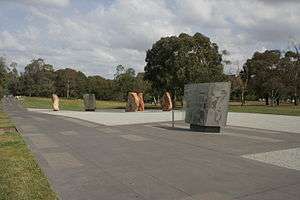Reconciliation Place

Reconciliation Place is an urban landscape design in the Parliamentary Triangle Canberra, Australia, commenced in 2001 as a monument to reconciliation between Australia’s Indigenous people and settler population.
The design was selected by a national design competition in 2001 run by the National Capital Authority with a jury including Ian Spicer, Matilda House, and RAIA Gold Medal architect Ric Leplastrier. The winning entry was designed by architect Simon Kringas. Sharon Payne was Indigenous Cultural Advisor.
The design is dominated by a convex mound in the landscape centred on Walter Burley Griffin's land and water axes, establishing a subtle presence while maintaining the overwhelming passage of the land axis and views to the lake from the steps of Old Parliament House.
"This vantage point is a nexus from which both axes can be simultaneously – and almost ethereally – experienced." .— Christopher Vernon[1]
Linking the Australian High Court and the National Library of Australia is a public promenade with artworks called "Slivers" displaying images and text on various themes of reconciliation including:
- A welcome to Ngunnawal country - an acknowledgment of the traditional owners of the land on which Reconciliation Place is being built
- The 1967 referendum that amended the Australian constitution to allow the Commonwealth Government to legislate on Aboriginal and Torres Strait Islander issues
- The recognition of native title rights which found that native title to land was part of Australia's common law
- The contribution Indigenous people have made, and continue to make, to Australia in sport and in the defence of our nation
- Indigenous leadership, depicting two great leaders — Neville Bonner and Vincent Lingiari and
- The past practice of separating Indigenous children from their families.
Since the opening of Reconciliation Place, new artworks have been added including:
- Three cast bronze slivers celebrating the role of female indigenous leadership, particularly in their contribution to Reconciliation in Australia through their roles in the 1967 Referendum. The artwork reflects leadership provided by Dr Faith Bandler, Lady Jessie Street, and Evelyn Scott.
- Three stone artwork celebrating the resilience and achievements of indigenous Australians who made contributions to Australian life. This includes artwork celebrating Ruby Hammond, Robert Lee, Wenten Rubuntja, Bill Neidjie and Gatjil Djerrkura.[2]
The promenade is intended to evolve over time with the addition of new artworks.[3]
The construction of Reconciliation Place was subject to a budget of only $3.5M, a limited timeframe (4 months for design and construction) and bureaucratic changes to the design. The intended geometric relationship to the neighbouring Commonwealth Place was not realised. It proposed that the Commonwealth Place ramp grade be marginally raised to join tangentially to the Reconciliation Place mound. After some delay this was supported by the Commonwealth Place designers but was then refused by the National Capital Authority. The ramp grade now terminates into the side of the mound.
"...the view up the Commonwealth Place ramp from the lake’s edge is foreshortened and terminated by the midden, its arcing profile outlined by the iconic flagpole of Aldo Giurgola’s magisterial Parliament House."— Christopher Vernon[4]
Similarly, precisely cut stone walls inscribing the pathways around the mound were replaced by earth berms, and recently installed 'Slivers' bear no relationship to the original design concept, resulting in a loss of coherence.
Despite the shortcomings in the relationship between Reconciliation Place and Commonwealth Place, Vernon maintains
"Both are design achievements of which the nation can be proud".— Christopher Vernon[5]
References
- ↑ "Christopher Vernon: Axial Occupation". Architecture Australia. Retrieved 2007-06-27.
- ↑ "Reconciliation Place: A lasting symbol of our shared journey" (PDF). Australian Federal Government. 2012.
- ↑ "Australian reconciliation". Department of Foreign Affairs and Trade (Australia). Archived from the original on 2006-10-11. Retrieved 2006-11-04.
- ↑ "Christopher Vernon: Axial Occupation". Architecture Australia. Retrieved 2007-06-27.
- ↑ "Christopher Vernon: Axial Occupation". Architecture Australia. Retrieved 2007-06-27.
Coordinates: 35°18′S 149°08′E / 35.300°S 149.133°E